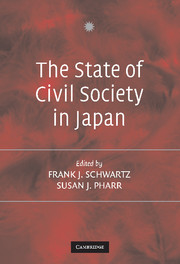Book contents
- Frontmatter
- Contents
- Tables and Figures
- Contributors
- Preface
- The State of Civil Society in Japan
- PART I CONTEXT
- PART II THE ASSOCIATIONAL SPHERE
- PART III THE NONMARKET ACTIVITIES OF ECONOMIC ACTORS
- PART IV STATE-CIVIL SOCIETY LINKAGES
- 11 Mobilizing and Demobilizing the Japanese Public Sphere: Mass Media and the Internet in Japan
- 12 A Tale of Two Systems: Prosecuting Corruption in Japan and Italy
- PART V GLOBALIZATION AND VALUE CHANGE
- Bibliography
- Author Index
- Subject Index
12 - A Tale of Two Systems: Prosecuting Corruption in Japan and Italy
Published online by Cambridge University Press: 05 July 2014
- Frontmatter
- Contents
- Tables and Figures
- Contributors
- Preface
- The State of Civil Society in Japan
- PART I CONTEXT
- PART II THE ASSOCIATIONAL SPHERE
- PART III THE NONMARKET ACTIVITIES OF ECONOMIC ACTORS
- PART IV STATE-CIVIL SOCIETY LINKAGES
- 11 Mobilizing and Demobilizing the Japanese Public Sphere: Mass Media and the Internet in Japan
- 12 A Tale of Two Systems: Prosecuting Corruption in Japan and Italy
- PART V GLOBALIZATION AND VALUE CHANGE
- Bibliography
- Author Index
- Subject Index
Summary
Independence and Accountability in Japan and Italy
This chapter explores the role and rule of law by telling a tale of two Systems for prosecuting corruption. In Japan, prosecutors have “limited independence” from outside political influence. In Italy, prosecutors are largely insulated from the world of electoral politics. This difference makes for a huge difference in the nature and scope of corruption prosecutions.
For example, Japan's Recruit Scandal of the late 1980s “came to symbolize an entire political establishment on the take” (Schlesinger 1997: 236). Prosecutors connected more than forty politicians to dubious Recruit payoffs, including nearly every ranking member of the ruling Liberal Democratic Party. Yet only two Diet politicians were indicted, neither of whom was prominent. In the 1990s, Italy's “Clean Hands” (Mani Pulite) investigation in the Tangentopoli (“Bribe City”) Scandal also implicated a whole political class, but with radically different results. In all, some 3,000 arrest warrants were issued, and at least 251 members of parliament and five former prime ministers were indicted (Nelken 1996). Ultimately, a small group of Italian prosecutors destroyed or caused the reconstitution of all the major parties of government (Burnett and Mantovani 1998: 6). These two scandals – Recruit and Tangentopoli – arose from similar forms of misconduct – bribery, extortion, and “political financing” – in similarly corrupt societies (Reed et al. 1996; Transparency International 1999). Whether measured by the size of the catch or the consequences of the investigation, however, they had radically different trajectories. This chapter explains why.
- Type
- Chapter
- Information
- The State of Civil Society in Japan , pp. 257 - 278Publisher: Cambridge University PressPrint publication year: 2003
- 2
- Cited by



